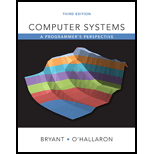
Explanation of Solution
Cache Addressing:
The primary storage hierarchy contains cache lines that are grouped into sets. If each set contains k lines then we say that the cache is k-way associative.
A data request has an address specifying the location of the requested data. Each cache-line sized chunk of data from the lower level can only be placed into one set. The set that it can be placed into depends on its address.
The number of cache sets is equal to the number of cache blocks divided by the number of ways of associativity.
The least significant bits are used to determine the block offset.
For example:
One needs to consider the following set associative (S, E, B, m) = (8, 4, 4, 13). The derived value will be as follows:
The Index (CI):
The block off set (CO):
The tag bit (CT):
Hence, the “2” lower bits are block offsets (CO); followed by 3 sets of bit index (CI) and the remaining bits are tag bits (CT).
The following table gives the parameters for a number of different caches and the number of cache sets(S), tag bits(t), set index bits (s) and block offset bits (b) are defined.
| Cache | m | C | B | E | S | t | s | b |
| 1 | 32 | 1024 | 4 | 1 | 256 | 22 | 8 | 2 |
| 2 | 32 | 1024 | 8 | 4 | 32 | 24 | 5 | 3 |
| 3 | 32 | 1024 | 32 | 32 | 1 | 27 | 0 | 5 |
The values for the above table are described below:
For cache-1:
It is given that
Hence:
For cache-2:
It is given that
Trending nowThis is a popular solution!

Chapter 6 Solutions
Computer Systems: A Programmer's Perspective Plus Mastering Engineering With Pearson Etext -- Access Card Package (3rd Edition)
 C++ for Engineers and ScientistsComputer ScienceISBN:9781133187844Author:Bronson, Gary J.Publisher:Course Technology Ptr
C++ for Engineers and ScientistsComputer ScienceISBN:9781133187844Author:Bronson, Gary J.Publisher:Course Technology Ptr Systems ArchitectureComputer ScienceISBN:9781305080195Author:Stephen D. BurdPublisher:Cengage Learning
Systems ArchitectureComputer ScienceISBN:9781305080195Author:Stephen D. BurdPublisher:Cengage Learning Enhanced Discovering Computers 2017 (Shelly Cashm...Computer ScienceISBN:9781305657458Author:Misty E. Vermaat, Susan L. Sebok, Steven M. Freund, Mark Frydenberg, Jennifer T. CampbellPublisher:Cengage Learning
Enhanced Discovering Computers 2017 (Shelly Cashm...Computer ScienceISBN:9781305657458Author:Misty E. Vermaat, Susan L. Sebok, Steven M. Freund, Mark Frydenberg, Jennifer T. CampbellPublisher:Cengage Learning C++ Programming: From Problem Analysis to Program...Computer ScienceISBN:9781337102087Author:D. S. MalikPublisher:Cengage Learning
C++ Programming: From Problem Analysis to Program...Computer ScienceISBN:9781337102087Author:D. S. MalikPublisher:Cengage Learning Principles of Information Systems (MindTap Course...Computer ScienceISBN:9781285867168Author:Ralph Stair, George ReynoldsPublisher:Cengage Learning
Principles of Information Systems (MindTap Course...Computer ScienceISBN:9781285867168Author:Ralph Stair, George ReynoldsPublisher:Cengage Learning A+ Guide to Hardware (Standalone Book) (MindTap C...Computer ScienceISBN:9781305266452Author:Jean AndrewsPublisher:Cengage Learning
A+ Guide to Hardware (Standalone Book) (MindTap C...Computer ScienceISBN:9781305266452Author:Jean AndrewsPublisher:Cengage Learning





